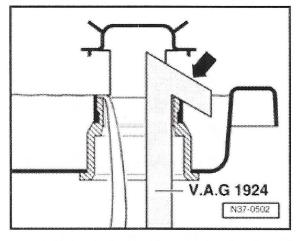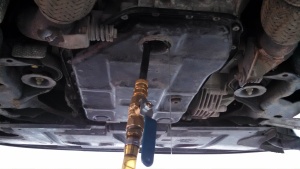- 10/16/2014
- 1 Min Read
- By: Chris Stovall
Checking Automatic Transmission Fluid in a Late Model VW/Audi
 The fill port - notice the special tool on the right and fluid pouring out on the left. The plastic piece above the tool can be an issue if you're not careful.
The fill port - notice the special tool on the right and fluid pouring out on the left. The plastic piece above the tool can be an issue if you're not careful.
Remember back in the day when you used to check your transmission fluid with a long dipstick? Have you looked for one on your car lately? The dipstick is the latest thing to get phased out under the hood – but with good reason. Before the days of included maintenance, owners would have to do their own services, or, more commonly, take it to the lowest bidder. The people working at a typical oil change chain (not going to name names here) would often top up the transmission with the wrong fluid, or overfill the transmission, and when it blows up, the manufacturer would replace it under warranty.
This was a colossal waste of time and money on everybody's part, so they sealed up the transmission, and it became difficult to check the transmission fluid level, which prevented warranty transmission replacement due to improper service. Newer transmissions on Volkswagens and Audis use the idea of thermal expansion to check the level of the transmission fluid. The fluid expands as it warms up, and when it reaches a certain temperature, the fill plug is removed, and the excess fluid runs out, leaving the perfect level in the pan. Sounds complicated, but it's actually pretty simple.
This procedure should apply to most VW/Audi vehicles with regular Tiptronic automatic transmissions - Not DSG boxes. The vehicle in particular being serviced is a B5 Volkswagen Passat.
Checking the fluid
To check your own fluid, you'll need a few tools. You'll need either a scan tool which is capable of reading the transmission fluid temperature or an infrared temperature gun. One of these is much cheaper than the other, so do what your budget will allow. You'll also need the special socket for the drain plug, in our case it's a 17 mm allen. Different transmissions have different fill plugs, so check yours first. You will also need your ATF, and a fluid transfer pump. There is a special tool that is supposed to be used for this, but it's very expensive, and chances are you'll only use it a handful of times, so a hand pump is okay.
First, make sure the vehicle is not warmed up and is perfectly level. The car needs to be absolutely level, to make sure that the fluid is able to run out at the right level. The drain is recessed in the pan, and when the fluid gets warm and expands, it runs out, as seen in the picture.
Make sure the transmission is less than 35 degrees Celsius. If it's not, come back later. The fluid cannot be checked above this temperature, and it's better if you can start with a dead cold transmission. If you're using the temp gun, scan along the pan until you get the highest temperature and use that spot as your temperature reading.
Next, start up the engine, and with your foot on the brake, go into each position on the shifter and hold it for ten seconds in each position. Return to Park to check the fluid.
[gallery columns="2" ids="6067,6070"]
With the engine running and transmission in Park, pull the fill plug out. Make sure the temperature is between 30 and 40 degrees Celsius, no more, no less. If fluid runs out in this temperature range, you're good. Wait until it's at a small stream, and then put the plug back in. If not, add fluid until it happens.
If your fluid transfer pump doesn't go in the fill port easily, don't stab it in there. There's a little plastic piece inside the pan directly above the hole, about an inch up, shown in the earlier picture. The special tool is used to avoid this, but if you're careful, it won't be an issue.
Newer cars come with “lifetime” fluid. I don't buy this for a second, and I recommend changing your transmission fluid at least every 60k. The fluid is usually filthy by this point, and it's much cheaper to replace the fluid than replace the transmission. If you do it yourself, do it right, and you'll get the most life possible out of your transmission.
Shop Volkswagen Suspension at FCP Euro
About the Author: Chris Stovall
 Chris is a journeyman mechanic from Berkeley, California, specializing in late model Volkswagens and Audis. A glutton for punishment, his spare time is spent rebuilding every component of his '83 Rabbit GTI.
Chris is a journeyman mechanic from Berkeley, California, specializing in late model Volkswagens and Audis. A glutton for punishment, his spare time is spent rebuilding every component of his '83 Rabbit GTI.












